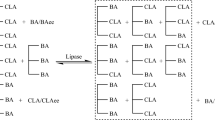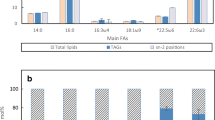Abstract
Enzymatic production of ABA-type structured lipids (SLs) containing marine-derived long-chain polyunsaturated fatty acid (n-3 PUFA) and medium-chain fatty acids was investigated. Response surface methodology was applied to optimize the reaction system and evaluate the effects of reaction factors and different acyl donors namely n-3 PUFA and n-3 PUFA ethyl esters (n-3 PUFA-EE). Well-fitting models were obtained by multiple regressions with backward elimination. For both n-3 PUFA and n-3 PUFA-EE systems, both reaction time and enzyme load had significant (P < 0.05) positive effects on incorporation and acyl migration rate. Water content were found to have significant (P < 0.05) negative effects on incorporation but positive effects on acyl migration in the n-3 PUFA-EE system. Although there were no significant difference in terms of incorporation rate, n-3 PUFA were found to produce five times higher acyl migration rate than n-3 PUFA-EE. The optimal reaction conditions to produce high yield of ABA-type SLs of 49.6% with low acyl migration rate of 2.6% were as follows: n-3 PUFA-EE as acyl donors; enzyme load, 6 wt.%; reaction time, 6 h; and water content, 3 wt.%. Thus, n-3 PUFA-EE was found to be a suitable acyl donor to produce high yield of ABA-type SLs with low acyl migration rate.


Similar content being viewed by others
References
Becker, C. C., Rosenquist, A., & Holmer, G. (1993). Regiospecific analysis of triacylglycerols using allyl magnesium bromide. Lipids, 28(2), 147–149.
Bloomer, S., Adlercreutz, P., & Mattiasson, B. (1991). Triacylglycerol interesterification by lipases 2: reaction parameters for the reduction of trisaturated impurities and diacylglycerols in batch reactions. Biocatalysis and Biotransformation, 5, 145–162.
Burr, M. L., Ashfied-Watt, P. A., Dunstan, F. D., Fehily, A. M., Breay, P., Ashton, T., et al. (2003). Lack of benefit of dietary advice to men with angina: results of a controlled trial. European Journal of Clinical Nutrition, 57, 193–200.
Calder, P. C. (1996). Immunomodulation and anti-inflammatory effects of n-3 polyunsaturated fatty acids. Proceedings of the Nutrition Society, 55, 737–774.
Cheong, L. Z., & Lai, O. M. (2009). Diacylglycerol oil: healthful or hype? International News on Fats, Oils and Related Materials: Inform, 20, 391–393.
Cheong, L. Z., Tan, C. P., Long, K., Yusuff, M. S. A., Ariffin, N., Lo, S. K., et al. (2007). Production of a diacylglycerol enriched palm olein using lipase catalyzed partial hydrolysis: optimization using response surface methodology. Food Chemisty, 105, 1614–1622.
Chopra, R., Rastogi, N. K., & Sambaiah, K. (2009). Enrichment of rice bran oil with α-linolenic acid by enzymatic acidolysis: optimization of parameters by response surface modelling. Food and Bioprocess Technology. doi:10.1007/s11947-009-0191-1.
Christensen, M. S., & Høy, C.-E. (1997). Early dietary intervention with structured triacylglycerols containing docosahexaenoic acid: effect on brain, liver, and adipose tissue lipids. Lipids, 32, 185–191.
Christensen, M. S., Høy, C.-E., Becker, C. C., & Redgrave, T. G. (1995). Intestinal absorption and lymphatic transport of eicosapentaenoic (EPA), docosahexaenoic (DHA), and decanoic acids: dependence on intramolecular triacylglycerol structure. American Journal of Clinical Nutrition, 61, 56–61.
Christopherson, S. W., & Glass, R. L. (1969). Preparation of milk fat methyl esters by alcoholysis in an essential nonalcoholic solution. Journal of Dairy Science, 52, 1289–1290.
Cleland, L. G., James, M. J., & Proudman, S. M. (2003). The role of fish oils in the treatment of rheumatoid arthritis. Drugs, 63, 845–853.
Cohen, J. T., Bellinger, D. C., Connor, W. E., Kris-Etherton, P. M., Lawrence, R. S., Savitz, D. A., et al. (2005). A quantitative risk-benefit analysis of changes in population fish consumption. American Journal of Preventive Medicine, 29, 325–334.
Fureby, A. M., Virto, C., Adlercreutz, P., & Mattiasson, B. (1996). Acyl group migrations in 2-Monoolein. Biocatalysis and Biotransformation, 14, 89–111.
Hamam, F., & Budge, S. M. (2009). Structured and specialty lipids in continuous packed column reactors: comparison of production using one and two enzyme beds. Journal of the American Oil Chemists' Society. doi:10.1007/s11746-009-1515-z.
Hamilton, S., Hamilton, R. J., & Sewell, P. A. (1992). Extraction of Lipids and derivative Formation. In S. Hamilton & R. J. Hamilton (Eds.), Lipid analysis—a practical approach (pp. 13–64). Oxford, UK: Oxford University Press.
Høy, C.-E., & Xu, X. (2001). Structured triacylglycerols. In F. D. Gunstone (Ed.), Structured and modified lipids (pp. 209–239). New York: Marcel Dekker.
Hu, F. B., Cho, E., Rexrode, K. M., Albert, C. M., & Manson, J. E. (2003). Fish and long chain omega-3 fatty acid intake and risk of coronary heart disease and total mortality in diabetic women. Circulation, 107, 1852–1857.
Knothe, G., & Dunn, R. O. (2009). A comprehensive evaluation of the melting points of fatty acids and esters determined by differential scanning calorimetry. Journal of the American Oil Chemists' Society, 86, 843–856.
Koh, S. P., Tan, C. P., Lai, O. M., Arifin, N., Yusoff, M. S. A., & Long, K. (2008). Enzymatic synthesis of medium- and long-chain triacylglycerols (MLCT): optimization of process parameters using response surface methodology. Food and Bioprocess Technology. doi:10.1007/s11947-008-0073-y.
Kris-Etherton, P. M., Harris, W. S., & Appel, L. J. (2002). Fish consumption, fish oil, omega-3 fatty acids and cardiovascular disease. Circulation, 106, 2747–2757.
Kristensen, J. B., Xu, X., & Mu, H. (2005a). Diacylglycerol synthesis by enzymatic glycerolysis: screening of commercially available lipases. Journal of the American Oil Chemists' Society, 82, 329–334. 7066.
Kristensen, J. B., Xu, X., & Mu, H. (2005b). Process optimization using response surface design and pilot plant production of dietary diacylglycerols by lipase catalyzed glycerolysis. Journal of Agricultural and Food Chemistry, 53, 7059–7066.
Lee, J.-H., & Lee, K.-T. (2006). Structured lipids production. In C. C. Akoh (Ed.), Handbook of functional lipids (pp. 489–512). USA: CRC Press.
Ruxton, C. H. S., Reed, S. C., Simpson, M. J. A., & Millington, K. J. (2004). The health benefits of omega-3 polyunsaturated fatty acids: a review of the evidence. Journal of Human Nutrition and Dietetics, 17, 449–459.
Shishikura, A., Fujimoto, K., Suzuki, T., & Arai, K. (1994). Imoproved lipase-catalyzed incorporation of long-chain fatty acids into medium-chain triglycerides assisted by supercritical carbon dioxide extraction. Journal of the American Oil Chemists' Society, 71, 961–967.
Xu, X. (2000). Enzymatic production of structured lipids: process reactions and acyl migration. Inform, 11, 1121–1130.
Xu, X. (2002). Response surface methodology for experimental optimization. Lipid Technology, 1, 17–19.
Xu, X., Skands, A. R. H., Høy, C.-E., Mu, H., Balchen, S., & Adler-Nissen, J. (1998). Production of specific-structured lipids by enzymatic interesterification: elucidation of acyl migration by response surface design. Journal of the American Oil Chemists' Society, 75, 1179–1186.
Xu, X., Balchen, S., Jonsson, G., & Adler-Nissen, J. (2000). Production of structured lipids by lipase-catalyzed interesterification in a flat membrane reactor. Journal of the American Oil Chemists' Society, 71, 1035–1041.
Acknowledgement
Financial supports from Research Council for Technology and Production (FTP), Food Science Australia, and Center for Advanced Food Studies (LMC) are acknowledged.
Author information
Authors and Affiliations
Corresponding author
Rights and permissions
About this article
Cite this article
Chen, B., Zhang, H., Cheong, LZ. et al. Enzymatic Production of ABA-Type Structured Lipids Containing Omega-3 and Medium-Chain Fatty Acids: Effects of Different Acyl Donors on the Acyl Migration Rate. Food Bioprocess Technol 5, 541–547 (2012). https://doi.org/10.1007/s11947-009-0322-8
Received:
Accepted:
Published:
Issue Date:
DOI: https://doi.org/10.1007/s11947-009-0322-8




